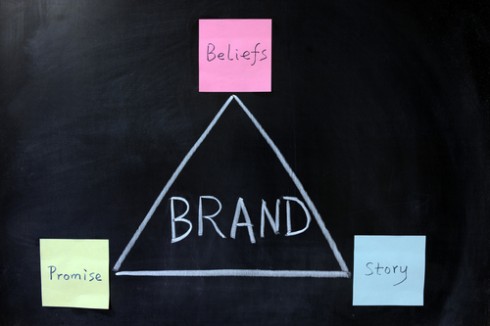The importance of establishing your brand in the era of Digital Darwinism cannot be overstated. Digital Darwinism occurs when technology and society evolve faster than one’s ability to adapt. Every brand is vulnerable, but no business is too big to fail or too small to succeed.
With customers today being increasingly connected, informed, and ultimately empowered, their expectations only escalate. In short, they are more discerning and demanding than ever before. The brand and the brand promise are of paramount importance. Without it, businesses instead rely on fleeting factors such as price, trends, events, gimmicks, and other elements that make it difficult to develop a long-term bond or relationship between a customer and the product or the brand.
When someone asks your customers what is it about your product or brand that draws them to you, what do you want them to say? What do you want people to feel?
As Amazon’s Jeff Bezos famously said, “Your brand is what people say about you when you’re not in the room.”
I spend a portion of Chapter 14 of, The End of Business as Usual exploring how the purchase cycle of connected customers is evolving and the important role brand plays in decision-making. I was inspired by the work of Kirk Phillips and his BrandSTOKE 9 Criteria for Brand Essence (TM). I’m writing this post because although I do cite his work, I don’t give enough credit to how significant a role his work plays in the understanding of this changing dynamic.
On pages 172 – 175 of the book, I adapt his 9 criteria to encompass the various elements I’ve experienced in working with companies that attempt to become more adaptive, connected, and social. Because it influenced me, I wanted to dedicate this post to his work so that it can inspire you as it did me.
Brand Essence and a Model for Emotive Engagement
The idea of Kirk’s 9 Criteria for Brand Essence is powerful. It goes beyond the basic principles of brand marketing. It’s the very essence of what inspires an organization to move in unison and drives the direction for employees and customers alike. The fabric, the spirit, the persona, the sheer imagery is whatever you make it. So when you think of your brand, what is it that you think or feel? If you had to use just one word to describe your brand’s essence what would it be? It is this answer that should inspire you to think about how it relates to a new genre of connected consumers or Generation-C as I refer to them. As Kirk says in thinking about your brand essence is that it’s “just one word that sums up how your brand connects emotionally with your customers.”
So, what is your “one word” that symbolizes all that your brand is or should be? Is it…?
Evocative
Aspirational
Ordinary
Utilitarian
Necessary
Immaterial
Rewarding
Of course, these are just a handful of emotional (or emotionless) words I’m using to get you thinking about what your words would be. See, how you define it and how your customers define it could in fact be dichotomous.
As Kirk observes, “articulating how they [your customers] feel about your brand in an authentic and meaningful way is often challenging. Few get it right. The reason: essence is an intangible.”
Essence is intangible and it’s an emotion. Emotions, at least those related to customer experiences not necessarily the emotions that run rampant in corporate culture, often steer clear of boardrooms. This is unfortunate as it is customer emotions that represent the very connection your brand does or does not make. And, these emotions serve as the foundations for shared experiences and expressions. It is your brand essence that is the very thing that inspires bonding or causes friction with customers. As they share these experiences, they impact the impressions and ultimately the decisions of others.
Essentially, your brand experience IS the foundation for engagement, emotive marketing, and word of mouth.
I wanted to share with you here, Kirk’s BrandSTOKE 9 Criteria for Brand Essence. This is an unedited excerpt from the post that still resonates with me today as it did then…
To help those who participate in determining a brand’s essence, here are the primary criteria. Test your essence against them.
1. single-minded: One word is ideal. Maybe two. More than two words indicates that the brand has no focus. As a brand (by design) delivers a unique experience, having no focus makes for a weak brand.
2. intangible: One is no more independent on a Harley-Davidson motorcycle than another brand, but somehow one feels like it. Tap into what the consumer feels.
3. unique: The essence of a brand is how it is different from competitors in the same category. E.g., if Apple (and its products) are friendly and approachable, then it is claiming that its competitors are not.
4. experiential: The essence captures what the consumer feels during an experience with the brand. E.g., “Driving a Volvo makes me feel that my family is safe.”
5. consistently delivered: If the proposed essence is not consistently experienced (e.g, if a trip to Walt Disney World isn’t magical), then it isn’t the essence. Can your organization deliver?
6. authentic: The essence must be credible or the brand will be rejected. To find out what consumers believe about your brand, ask them. It’s okay for the brand essence to be aspirational, but only if your customers believe you can deliver on the promise.
7. sustainable: A brand’s essence is baked in. It doesn’t change. Ever.
8. meaningful: There is no point in identifying an essence that is irrelevant to consumers. Essences that don’t connect are the reason behind many failed brands. Again, research.
9. scalable: Will the essence work for brand extensions? Will it work as the brand’s opportunity grows?
For more, please download Kirk Phillips’ ebook, BrandSTOKE 9 Criteria for Brand Essence.
Connect with me: Twitter | LinkedIn | Facebook | Google+
The End of Business as Usual is officially here…
Image Credit: Shutterstock







I believe that if you want your brand to be alive in 2013 you must provide more value cause as you mentioned people are more demanding nowadays!!
Hi Brian – Thanks for the post, and I’m looking forward to digging into, ‘The End of Business as Usual’… it’s next on my reading list.
Kirk’s definition of a brand essence is fantastic as it is easily digestible, succinct, and of course makes complete sense. Having worked in the advertising industry for some time now, and having had numerous brand-related discussions, it is incredible to me how difficult it is to get a group of individuals to agree on what exactly a brand essence should be, and what role it should play in the context of their business, marketing, consumer engagement, etc. The points outlined here will be a great tool and resource for future discussions.
One comment I’d like to make is to do with the 9th point, ‘Scalability’, for testing your essence, and particularly the question about whether your essence will work for brand extensions. It’s a simple reversal regarding how one should look at this, but I believe that brand extensions should be tested against the essence for their viability, not necessarily the other way around. If brand extensions don’t deliver on the essence and brand positioning, I believe they should probably be re-branded or launched independently because of their irrelevance to the parent brand, and the dilution of the brand essence that their existence could cause.
Anyway, just my two cents, and thanks again for the post.
Matthew.
Thank you for a great comment. Interesting take…curious to hear Kirk’s thoughts.
Matthew, I agree with the practice of testing the extension against the essence. Disney serves as a great example of an intangible brand essence that has successfully scaled across several industries — from movies to toys to theme parks to TV networks to cruises. The inability of a brand essence to scale may have more to do with poor extension strategy than the weakness of the essence. Thanks for the comment!
No problem Kirk, I appreciate you weighing in. The Disney example is a great one for a brand that – as far as I’m aware – has done a nice job consistently delivering against their essence with each extension.
Very informative. Thanks for sharing!
The essence of a brand – emotional branding proposition (EBU). I agree with Kirk 100% – we are emotionally connected to brands … whether consumers know it or not, they build certain rapports with brands and the latter should realize that and capitalize on it.
Thanks for sharing Brian – by the way, loved “Engage” & “End of Business as Usual” – however, you still haven’t answered me – why did you decide to include a chain on both your book covers!
Cheers,
JA
Hello John. Thanks for the comment. Kirk’s work is right on. Re: the chain, we’ll it’s symbolic in that we’re trying to change the future of business while still shackled in tradition. At some point, we’ll break free. You’ll notice the chain makes an appearance on the next book cover as well. 🙂
Finally – The secret is revealed! Thank you for sharing that with me! Looking forward to the next book in the “chain” of command 😉
Witty! Thanks also for reading the books!
In a world that is now dominated by consumerism, a brand has become the essential identity for anyone that sells anything. We have moved away from thinking of brands as being huge corporations or chain stores to seeing that we each have to develop our own individual brands to represent ourselves to the world. Most of us have chosen specific gravatars, domain names and other specific identifiers to differentiate our individuality from other people and branding is just an extension of this principal. Thanks for the informative article.
I have to agree with both Mr. Antonios and Mr. Kirk that we emotionally connect with our brands. Being a senior studying journalism, public relations and communication studies the study of branding comes up frequently. We often discuss how the root of public relations, connecting and building relationships with your audience, engages with branding, creating a combination that appeals to your consumers that speaks on their morals, belief and identity. Great post. Thank you for your insight.
Thank you for sharing Natashia!
I’m taking a Social Media for PR class, and we’ve talked a little about how branding can seem impersonal and sometimes even a little inhuman. The way Antonios and Kirk speaks of how our emotions connect with brands humanizes branding. It would be interesting to see their stances on personal branding, and not just product or company branding. Thanks for the post, and thanks for “Engage!” We’ve been using it in class.
Cheers Carrie!
. Nice and very informative. I am studying this problem and I must say that your article has helped me a lot.
Inspirational piece Brian. Brand Essence reminds me of one of my favorite quotes:
“I’ve learned that people will forget what you said, people will forget what you did, but people will never forget how you made them feel.” by May Angelou
I have found this quote to be consistent with my own experiences in life, with both people and the brands they represent.
Thanks for sharing
Maya Angelou’s quote is so important. Thank you Rick.
Excellent post, Brian. I totally agree with your statement, “See, how you define it and how your customers define it could in fact be dichotomous.”
In over a decade of marketing for Fortune 500 firms, I have found this to be absolutely true. Many are completely out of touch with their brand’s perception and shows the need for three tactics:
1. Continuous brand monitoring, not just through social media, but also through ethnography, clipping services, surveys, etc.
2. Perception Gap Charts. These need to be based on the data from monitoring, and used to show the distance between how the brand sees itself and how customers perceive it.
3. True Competitive Reviews: Most brands stop at who THEY think their competitors are, often based on sales data, share of market, etc. Yet, most do not stop to ask their customers (or use social monitoring to uncover) who their customers think the brand’s competition is. It’s often radically different, more honest and somewhat of a humbling experience for most brands that may be acting loftier than they should.
Thank you Dave!
Mr. Solis,
I found this post to be an extremely well-written and interesting look at brand building in an environment that is increasingly driven by technology. As an undergraduate student interested in public relations and the psychology of branding, I recognize the relevance and importance of exploring how brands function in the digital realm. In regards to the state of today’s branding environment, I found the term “Digital Darwinism” especially appropriate for the phenomena consumers are seeing today. However, I would be curious to hear why exactly you think companies are not able to keep up with their competitors and are quickly disappearing. Yes, the fast-paced environment of digital innovation is often difficult to keep up with, and that undoubtedly contributes to businesses going bankrupt and failing. But what role do you think branding plays? Looking at a company like Polaroid, which had a very strong brand image that was rooted in film rather than digital technology, it’s clear to see they were late getting on the digital photo bandwagon. But do you think a different branding strategy could have potentially saved the business, or at least gave it some more time to construct a better plan of attack?
As to the criteria you address in this post, I also found Kirk’s model to be effective guidelines for analyzing brand essences, and a practically irrefutable strategy to follow when evaluating new marketing tactics and extensions. I believe the distinction in establishing the difference between brand marketing and the essence of the brand is a very important one. So often, it appears companies focus on the relatively short-term necessities of building an integrated marketing campaign, and lose sight that their brand essence is what drives behavior. In this respect, sustainability would appear to be an especially important criterion, and often the easiest for companies to lose sight of – particularly when extending their brand from one product or platform to another. From what I have seen in the public relations industry, businesses often try to give turn their brand essences into company voices. However, because the brand essence exists solely in the minds of consumers, it is psychological concept that is often a difficult thing to categorize and describe, much less utilize in an effective way when expanding to a new marketing strategy. How do you see the concept of the brand essence carrying over to voices in digital marketing and social media, in particular?
Again, this was a very insightful and informative post, and I look forward to reading more in the future.
Jennifer Schultz
Thank you for such a thoughtful comment. Your question begs a deeper response. It’s incredibly important and have included the subject matter in many of my posts and books over the years. Here’s one example that may help… https://www.briansolis.com/2010/06/the-social-media-style-guide-8-steps-to-creating-a-brand-persona-2/ Cheers Jennifer.
This article covers a lot of informative content that I’ve been searching for a long time. Thanks for sharing.
This article is spot on. Kirk’s description of a brand essence being how the consumer sees the brand’s persona or spirit is what many companies do not realize. As the world becomes more interconnected, brands will have to clearly define their brand experience. This will also drive many companies to begin considering the emotions of their consumers. The Disney brand understands the importance of their customers’ emotions and uses it to build upon each experience. Going forward, companies will have to focus on both customer experience and emotions to stay relevant in the marketplace. Kirk’s insights into this aspect of brand strategy are what many companies should pay attention to. Thanks for sharing Brain.